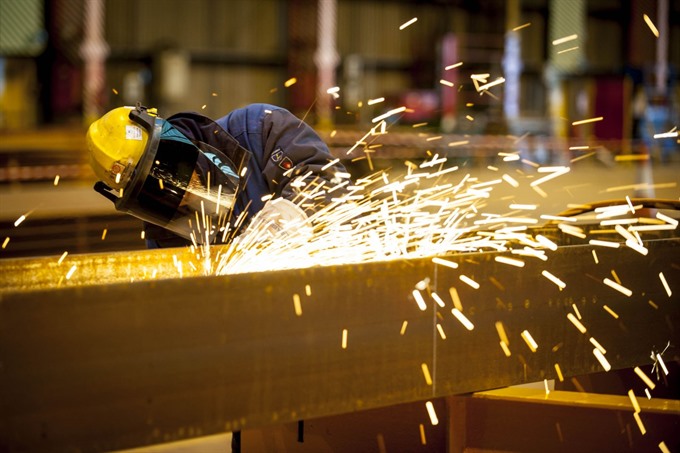HÀ NỘI – The steel industry is expected to maintain its recent double-digit growth this year, helped by the recovery of the property market, but it will also face the pressure of trade defense instruments in import markets and competition from cheap steel.
Several local steel producers have set lower growth targets this year after a rosy 2016 that enjoyed an improved domestic economy, higher steel prices and application of anti-dumping duties on Chinese steel.
Nguyễn Văn Sưa, Deputy President of the Việt Nam Steel Association, said that it was necessary for local producers to be cautious about business targets this year because supportive factors were not as good as last year.
Sưa said that the association has forecast a sales growth of 12 per cent this year, lower than last year’s 17 per cent.
Trần Đình Long, chairman of the Hòa Phát Group, a leading steel producer in the country, was quoted by
enternews.vn as saying that the industry would continue to be fuelled by the recovery of the property market until 2018.
However, the group has set an after-tax profit target at VND600 trillion (US$263 million), VNĐ600 billion lower than last year’s result.
The Hoa Sen Group has also set lower gross profit growth target at 10 per cent respectively for 2017, after a 130 per cent growth rate last year.
Nguyễn Ngọc Anh, chairman of steel distribution firm SMC Trading Investment Joint Stock Company, which has set its 2017 after-tax profit target at nearly half of last year, said that the local steel industry was still heavily dependent on global prices.
“Steel prices are on a downward trend, so local producers should be cautious,” Ngọc Anh said.
According to the Việt Nam Steel Association, the price of construction steel in the local market has dropped by around VNĐ600-800 per kilogram in the first quarter of this year and that of iron ore is forecast to drop to around $74 per tonne by June from $80.9 at the end of March. Scrap steel is also on a downward trend at around $265-270 per tonne at present from $315 in 2016.
The association said that the drops in price were caused by the letting out of inventories as well as competition among producers to maintain their market share.
Sưa said that steel exports would continue to struggle in 2017 due to pressure from the investigation and application of trade defense instruments by import markets.
Many countries were enhancing application of trade defense instruments against Vietnamese steel, he said.
Statistics compiled by the Việt Nam Chamber of Commerce and Industry show that as of the end of July 2016, out of 100 anti-dumping lawsuits, 20 related to the steel industry.
The Việt Nam Steel Corporation has advised local producers to enhance competitiveness by improving production efficiency as well as market analysis.
It has also called on the Government to issue policies to prevent mass inflow of cheap steel, especially from China, as well as trade fraud.
In the first quarter of this year, steel output reached 4.6 million tones, up 18.8 per cent over the same period last year. Sales rose 6.5 per cent during this period to reach 3.76 million tones.
Việt Nam imported finished steel products totalling 3.56 million tones worth $2.2 billion in the first quarter, up 13 per cent and 64 per cent year-on-year, respectively.
Scrap worries
Scrap steel imports in the first three months of the year increased sharply compared to last year, up more than 45 per cent in volume and 120 per cent in turnover, although this product is difficult to manage and poses serious environmental threats.
According to the General Department of Customs, Việt Nam imported more than a million tonnes of scrap steel in Q1, valued at over US$276 million, at an average price of $260 per tonne. This is more than 11,000 tonnes a day, 1,000 tonnes higher than the average import in 2016.
Scrap steel is mostly imported from the US, China, Korea, Japan and Taiwan.
Local experts attribute the massive scrap steel imports to the country using out-dated technologies that make it a main material for steel production. This is a low-cost process, but only 60-70 per cent of scrap steel is ultilised, with the remaining removed in the production process.
More than 54 departments of Natural Resources and Environment have reported to the Ministry of Natural Resources and Environment (MoNRE) that many facilities and enterprises recycling and processing scrap steel do not meet environmental protection standards.
By the end of 2014, Việt Nam had a total of 349 establishments importing and recycling scrap steel. — VNS
 Economy
Economy






